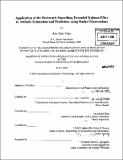| dc.contributor.advisor | David Chan and John E. Keesee. | en_US |
| dc.contributor.author | Volpe, Kyle Clarke | en_US |
| dc.contributor.other | Massachusetts Institute of Technology. Dept. of Aeronautics and Astronautics. | en_US |
| dc.date.accessioned | 2010-02-09T16:56:05Z | |
| dc.date.available | 2010-02-09T16:56:05Z | |
| dc.date.copyright | 2009 | en_US |
| dc.date.issued | 2009 | en_US |
| dc.identifier.uri | http://hdl.handle.net/1721.1/51646 | |
| dc.description | Thesis (S.M.)--Massachusetts Institute of Technology, Dept. of Aeronautics and Astronautics, 2009. | en_US |
| dc.description | Includes bibliographical references (p. 317-322). | en_US |
| dc.description.abstract | The Lincoln Attitude Estimation System (LAES), a new tool being developed for the Space Situational Awareness Group (SSAG) at MIT Lincoln Laboratory, integrates several existing hardware and software systems, with a backward-smoothing extended Kalman filter (BSEKF). LAES is intended to determine the rotational motion of a freely tumbling spacecraft from a sequence of discrete-time radar images. The raw range-Doppler returns are collected using a ground-based sensor, which is owned and operated by the SSAG, and processed into a set of range/cross-range images. A three-dimensional geometric model is, through computer graphics procedures, displayed on top of the two-dimensional radar images, enabling an analyst to rotate (and scale in cross-range) the model in order to align it to the object's image. Therefore, the orthographic projection matrix that the computer graphics procedures computed to display the computer model, simultaneously describes the projection of the object onto the radar image plane. These measurements are essentially corrections to a nominal or baseline motion which had to be assumed in order to generate the images in the first place. Combining the reference motion, which describes the orientation of the image plane in inertial space, with the sequence of rotations describing the attitude of the spacecraft within the image plane, yields the final set of attitude measurements which are then passed to the BSEKF for processing. | en_US |
| dc.description.abstract | (cont.) The existing free motion software currently in use within the Space Situational Awareness Group makes two critical assumptions: 1) that that the spacecraft is a symmetric rigid body and 2) that there are no disturbance torques acting on the spacecraft during the imaging period. The Lincoln Attitude Estimation System removes these simplifying assumptions in favor of a more flexible approach which is better suited for long-term studies of rigid body motion. Accordingly, several additions have been made to the backward-smoothing extended Kalman filter, including the addition of environmental torque models and an algorithm which generates an initial estimate for the inertia tensor using the same geometric model used in the image-model matching process. The BSEKF solves a nonlinear smoothing problem for the current and past sample intervals using iterative numerical techniques. This approach retains the nonlinearities of a fixed number of stages that precede the time of interest, and processes information from earlier stages in an approximate manner. The algorithm has been tested using simulated and actual data from a challenging spacecraft attitude estimation problem in which there is significant measurement noise, poor initial state estimates, and highly nonlinear system dynamics. The filter compensates for this uncertainty through concurrent estimation of the attitude and moment of inertia parameters. The filter has been demonstrated to accurately and reliably converge on a motion solution in both types of test cases. | en_US |
| dc.description.statementofresponsibility | by Kyle Clarke Volpe. | en_US |
| dc.format.extent | 322 p. | en_US |
| dc.language.iso | eng | en_US |
| dc.publisher | Massachusetts Institute of Technology | en_US |
| dc.rights | M.I.T. theses are protected by
copyright. They may be viewed from this source for any purpose, but
reproduction or distribution in any format is prohibited without written
permission. See provided URL for inquiries about permission. | en_US |
| dc.rights.uri | http://dspace.mit.edu/handle/1721.1/7582 | en_US |
| dc.subject | Aeronautics and Astronautics. | en_US |
| dc.title | Application of the backward-smoothing extended Kalman filter to attitude estimation and prediction using radar observations | en_US |
| dc.title.alternative | Application of the BSEKF to attitude estimation and prediction using radar observations | en_US |
| dc.type | Thesis | en_US |
| dc.description.degree | S.M. | en_US |
| dc.contributor.department | Massachusetts Institute of Technology. Department of Aeronautics and Astronautics | |
| dc.identifier.oclc | 496820954 | en_US |
